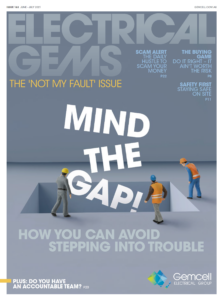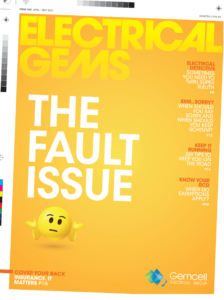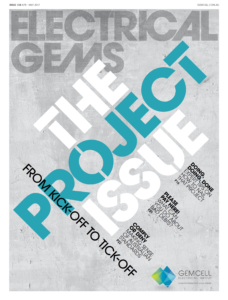Out Now
The Infrastructure Issue
Current Issue
The Infrastructure Issue
JUN - JUL 2025

Find out how to protect yourself and your clients from a cyberattack.
If cybercrime wasn’t on your radar before, it certainly will be now. Between the Medibank and Optus breaches, many Australians have been affected, leaving both businesses facing the aftermath.
While Medibank and Optus have the backing to hopefully survive, these incidents brought with them the stark realisation that every business – and consequently, every customer – is a potential victim of cybercrime.
Cybercrimes today are a huge and ever present threat for everyone around the world.
Every seven minutes, the Australian Cyber Security Centre (ACSC) receives a report of a cyberattack (just think of the number that go unreported, too) and in the past year, there were 76,000 cybercrime reports, an increase of approximately 12.6 per cent from the previous year.
In some respects, however, it’s easier to protect a small business than a large outfit like Optus. You’ve got fewer people, fewer ways in, and your data’s less valuable.
However, naturally, small businesses will have far less protection and cyber know-how than the bigger players.
In reality, they’re much easier targets.
It’s time to redress that balance.
Okay, first things first. It’s important we all know what we’re talking about here. So, let’s recap.
A cybercrime either uses or targets computers or other information communication technologies (ICTs) to carry out any criminal activities either for financial gain, to seek retribution, or for political reasons. These attacks can maliciously disable sophisticated computer networks, steal sensitive and private information, and initiate other criminal activities like cyberbullying, identity theft, email fraud, cyber extortion, and the sale of data and other illegal items.
As more people rely on internet-connected technologies and services, there is more opportunity for cybercriminals to carry out cybercrime activities using the anonymity of the internet.
Cybercrime is now big, big business, and is constantly evolving to counter advances in security systems, finding weaknesses to exploit and launch attacks on individuals, businesses, and the government.
Cybersecurity comprises protections based on people, processes, and technology. When one area is weak, that is what is targeted,” says Mike Ouwerkerk, the founder of Web Safe Staff.
According to Ryan O’Kell, Head of Cyber Security (APAC) at Waterstons Australia, the sophistication of cybercrime has evolved drastically over the last decade.
“The biggest evolution has been in the methods adversaries are using to monetise their access,” he explains.
“Ransomware crews have gone from just leaving a message saying, ‘Pay us’ to actually exfiltrating the data and saying, ‘Pay us, or we release all of your company’s information publicly.’”
Exhibit A: Medibank.
The recent data breaches at Optus and Medibank collectively affected 19.7 million Australian customers.
In terms of wake-up calls, it rivals a combination of alarm clocks, a flock of roosters and a wandering band of pan-playing minstrels entering your room at 6am.
Cybercrime is a reality and is on the rise.
And you need to get your business as cyberattack-proof as possible. Otherwise, your business will grind – very quickly – to a standstill.
“A typical incident we respond to sees most staff sent home for the day, work comes to a halt, and third parties are informed that they’ve got a problem,” explains O’Kell.
As businesses store more of their customers’ data, they are increasingly at risk of cyberattacks.
“Work from home added new complexities around this, because now there are additional devices and networks outside of the control of IT, and these are often far less protected,” adds Ouwerkerk.
In 2021, the estimated cost to the Australian economy was a staggering $42 billion, according to the UNSW Institute for Cyber Security, while a 2022 study by IBM shows human errors account for 21 per cent of the breaches and IT failures result in two per cent of breaches responsible for data loss.
Small businesses make ideal targets for cybercriminals – without a full-time IT staff, small businesses are more vulnerable to data breaches and cyberattacks.
Besides financial damages, lost customer trust and cost to the reputation of the business, some small businesses may face extensive breach fines and penalties, which can amount to thousands of dollars.
The responsibility of keeping data secure lies with the business, especially when storing their customer’s information.
Business owners need to understand, identify, and guard against risks. O’Kell advocates proper planning to minimise the cost and damages and suggests implementing simple security measures at the very least.
“Daily backups that are offline or immutable can be the difference between being back online tomorrow and losing months of data. A robust detection system can be the difference between finding an adversary in your network and ejecting them before damage is done, or losing time, money and your customers’ trust.”
“Looking towards the immediate future, it appears that breaches will continue to rise,” says Ouwerkerk. “There’s an alarming lack of preparedness around data breaches for many companies, and staff remain largely untrained in spotting and dealing with scams.”
While more individuals are noticing data breaches of their personal information and learning what to do about them, businesses are falling behind.
Presumably, they will take cybersecurity more seriously with the introduction of new penalties around data breaches, creating fresh challenges.
“As cybersecurity expertise can be hard to come by, and a flood of demand will mean a lack of service or potentially substandard service as less capable vendors attempt to cater for the high demand,” Ouwerkerk explains.
“Unfortunately, with this demand, it would be reasonable to expect the price of cybersecurity services to increase.”
Like it or not, cybersecurity is a huge, huge threat – and as a business, it simply has to be taken seriously.
The warning shots have been fired.
Keep up to date with our latest news and competitions by subscribing to our regular newsletter.

Issue 183
OCT - NOV 2024

Issue 182
AUG - SEPT 2024

Issue 181
JUN - JUL 2024

Issue 180
APR - MAY 2024

Issue 179
FEB - MARCH 2024

Issue 178
DEC 2023 - JAN 2024

Issue 177
OCT - NOV 2023

Issue 176
AUG - SEPT 2023

Issue 175
JUN - JUL 2023

Issue 174
APR - MAY 2023

Issue 173
FEB - MAR 2023

Issue 172
DEC 2022 - JAN 2023

Issue 171
OCT - NOV 2022

Issue 170
AUG - SEPT 2022

Issue 169
JUN - JUL 2022

Issue 168
APR - MAY 2022

Issue 167
FEB - MAR 2022

Issue 166
DEC 2021 - JAN 2022

Issue 165
OCT - NOV 2021

Issue 164
AUG - SEPT 2021

Issue 163
JUN - JUL 2021

Issue 162
APR - MAY 2021

Issue 161
FEB - MAR 2021

Issue 160
DEC 2020 - JAN 2021

Issue 159
OCT - NOV 2020

Issue 158
AUG - SEPT 2020

Issue 157
JUN - JUL 2022

Issue 156
APR - MAY 2020

Issue 155
FEB - MAR 2020

Issue 154
DEC 2019 - JAN 2020

Issue 153
OCT - NOV 2019

Issue 152
AUG - SEPT 2019

Issue 151
JUN - JUL 2019

Issue 150
APR - MAY 2019

Issue 149
FEB - MAR 2019

Issue 148
DEC 2018 - JAN 2019

Issue 147
OCT - NOV 2018

Issue 146
AUG - SEPT 2018

Issue 145
JUN - JUL 2018

Issue 144
APR - MAY 2018

Issue 143
FEB - MAR 2018

Issue 142
DEC 2016 - JAN 2017

Issue 141
OCT- NOV 2017

Issue 140
AUG - SEPT 2017

Issue 139
JUN - JUL 2017

Issue 138
APR - MAY 2017

Issue 137
FEB - MAR 2017

Issue 136
DEC 2016 - JAN 2017

Issue 135
OCT - NOV 2017

Issue 134
AUG - SEPT 2016

Issue 133
JUN - JUL 2016

Issue 132
APR - MAY 2016

Issue 131
FEB - MAR 2016

Issue 130
DEC 2015 - JAN 2016

Issue 129
OCT - NOV 2015

Issue 128
AUG - SEPT 2015

Issue 127
JUN - JUL 2015

Issue 125
APR - MAY 2015

Issue 125
FEB - MAR 2015

Issue 124
DEC 2014 - JAN 2015

Issue 123
OCT - NOV 2014

Issue 122
AUG - SEPT 2014

Issue 121
JUN - JUL 2014

Issue 120
APR - MAY 2014

Issue 119
FEB - MAR 2014

Issue 118
DEC 2013 - JAN 2014

Issue 117
OCT - NOV 2013

Issue 116
AUG - SEPT 2013

Comments (0)
Write a Comment